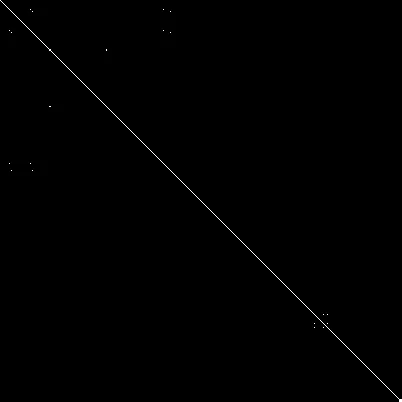我希望为图像中的每个关键点获得距离向量d。距离向量应包括从该关键点到该图像中所有其他关键点的距离。 注意:使用SIFT找到关键点。
我对opencv还不太熟悉。在C ++中是否有库函数可以使我的任务变得更加容易?
我希望为图像中的每个关键点获得距离向量d。距离向量应包括从该关键点到该图像中所有其他关键点的距离。 注意:使用SIFT找到关键点。
我对opencv还不太熟悉。在C ++中是否有库函数可以使我的任务变得更加容易?
如果您对位置距离不感兴趣而是对描述符距离感兴趣,您可以使用以下方法:
cv::Mat SelfDescriptorDistances(cv::Mat descr)
{
cv::Mat selfDistances = cv::Mat::zeros(descr.rows,descr.rows, CV_64FC1);
for(int keyptNr = 0; keyptNr < descr.rows; ++keyptNr)
{
for(int keyptNr2 = 0; keyptNr2 < descr.rows; ++keyptNr2)
{
double euclideanDistance = 0;
for(int descrDim = 0; descrDim < descr.cols; ++descrDim)
{
double tmp = descr.at<float>(keyptNr,descrDim) - descr.at<float>(keyptNr2, descrDim);
euclideanDistance += tmp*tmp;
}
euclideanDistance = sqrt(euclideanDistance);
selfDistances.at<double>(keyptNr, keyptNr2) = euclideanDistance;
}
}
return selfDistances;
}
使用此代码会得到一个 N x N 的矩阵(其中N是关键点的数量),其中Mat_i,j = 关键点i和j之间的欧几里得距离。
对于这个输入:

我得到了以下输出:


备注:您可以在计算矩阵时优化许多内容,因为距离是对称的!
更新:
从您的聊天记录中,我知道您需要13GB内存来保存41381个关键点的距离信息(您已尝试过)。如果您只想要N个最佳匹配项,请尝试此代码:
// choose double here if you are worried about precision!
#define intermediatePrecision float
//#define intermediatePrecision double
//
void NBestMatches(cv::Mat descriptors1, cv::Mat descriptors2, unsigned int n, std::vector<std::vector<float> > & distances, std::vector<std::vector<int> > & indices)
{
// TODO: check whether descriptor dimensions and types are the same for both!
// clear vector
// get enough space to create n best matches
distances.clear();
distances.resize(descriptors1.rows);
indices.clear();
indices.resize(descriptors1.rows);
for(int i=0; i<descriptors1.rows; ++i)
{
// references to current elements:
std::vector<float> & cDistances = distances.at(i);
std::vector<int> & cIndices = indices.at(i);
// initialize:
cDistances.resize(n,FLT_MAX);
cIndices.resize(n,-1); // for -1 = "no match found"
// now find the 3 best matches for descriptor i:
for(int j=0; j<descriptors2.rows; ++j)
{
intermediatePrecision euclideanDistance = 0;
for( int dim = 0; dim < descriptors1.cols; ++dim)
{
intermediatePrecision tmp = descriptors1.at<float>(i,dim) - descriptors2.at<float>(j, dim);
euclideanDistance += tmp*tmp;
}
euclideanDistance = sqrt(euclideanDistance);
float tmpCurrentDist = euclideanDistance;
int tmpCurrentIndex = j;
// update current best n matches:
for(unsigned int k=0; k<n; ++k)
{
if(tmpCurrentDist < cDistances.at(k))
{
int tmpI2 = cIndices.at(k);
float tmpD2 = cDistances.at(k);
// update current k-th best match
cDistances.at(k) = tmpCurrentDist;
cIndices.at(k) = tmpCurrentIndex;
// previous k-th best should be better than k+1-th best //TODO: a simple memcpy would be faster I guess.
tmpCurrentDist = tmpD2;
tmpCurrentIndex =tmpI2;
}
}
}
}
}
它会计算第一个描述符的每个关键点与第二个描述符的N个最佳匹配项。因此,如果您想要对相同的关键点执行此操作,可以在您的调用中设置descriptors1 = descriptors2,如下所示。记住:函数不知道两个描述符集是相同的,因此第一个最佳匹配(或至少一个)将始终是关键点本身,距离为0!如果使用结果,请记住这一点!
以下是生成类似于上图的图像的示例代码:
int main()
{
cv::Mat input = cv::imread("../inputData/MultiLena.png");
cv::Mat gray;
cv::cvtColor(input, gray, CV_BGR2GRAY);
cv::SiftFeatureDetector detector( 7500 );
cv::SiftDescriptorExtractor describer;
std::vector<cv::KeyPoint> keypoints;
detector.detect( gray, keypoints );
// draw keypoints
cv::drawKeypoints(input,keypoints,input);
cv::Mat descriptors;
describer.compute(gray, keypoints, descriptors);
int n = 4;
std::vector<std::vector<float> > dists;
std::vector<std::vector<int> > indices;
// compute the N best matches between the descriptors and themselves.
// REMIND: ONE best match will always be the keypoint itself in this setting!
NBestMatches(descriptors, descriptors, n, dists, indices);
for(unsigned int i=0; i<dists.size(); ++i)
{
for(unsigned int j=0; j<dists.at(i).size(); ++j)
{
if(dists.at(i).at(j) < 0.05)
cv::line(input, keypoints[i].pt, keypoints[indices.at(i).at(j)].pt, cv::Scalar(255,255,255) );
}
}
cv::imshow("input", input);
cv::waitKey(0);
return 0;
}
keypoint类有一个成员称为pt,它本身具有x和y作为其自己的成员 [表示点的(x,y)位置]。
给定两个关键点kp1和kp2,那么计算欧几里得距离就很容易了:
Point diff = kp1.pt - kp2.pt;
float dist = std::sqrt( diff.x * diff.x + diff.y * diff.y )
std::vector< std::vector< float > > item;按照a-Jays的建议计算距离
Point diff = kp1.pt - kp2.pt;
float dist = std::sqrt( diff.x * diff.x + diff.y * diff.y );
使用push_back将每个关键点添加到向量中 --> N次。